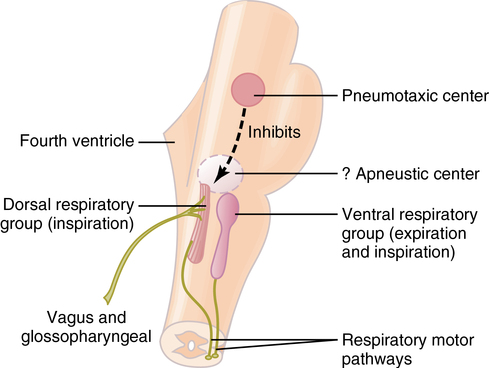Central regulation of ventilation
Ventilation is regulated to maintain optimal and unchanging levels of pH, CO2, and O2 in the blood. This regulation is provided via the respiratory center, which receives afferent input from chemical stimuli and peripheral chemoreceptors. The respiratory center is composed of a group of nuclei in four major areas within the medulla and pons (Table 25-1).
Table 25-1
Neurons within the Medulla and Pons That Constitute the Respiratory Center
| Center | Location | Nuclei | Function |
| Dorsal respiratory (inspiratory center) | Dorsal portion of the medulla | Nucleus tractus solitarius | Results in inspiration when stimulated |
| Pneumotaxic center | Upper portion of the pons | Nucleus parabrachialis | Controls rate and pattern of breathing; limits inspiration |
| Ventral respiratory group (expiratory center) | Anterolateral portion of the medulla (∼5 mm anterior and lateral to dorsal respiratory group) | Nucleus ambiguus and nucleus retroambiguus | Primarily causes expiration; depending upon which neurons are stimulated, can cause expiration or inspiration; transmits inhibitory impulses to the apneustic center |
| Apneustic center | Lower portion of the pons | Discharges stimulatory impulses to the inspiratory center, resulting in inspiration; receives inhibitory impulses from the pneumotaxic center and from stretch receptors of lung; discharges inhibitory impulses to the expiratory center |

Neural control
Inspiratory center
The inspiratory center, the site of basic respiratory drive, located dorsally in the medulla, extends the full length of the medulla (Figure 25-1). The neurons within the inspiratory center are located near the termination sites of afferent fibers from the glossopharyngeal (IX) and vagus (X) nerves. These neurons have intrinsic automaticity and normally fire for 2 sec, with a ramp effect of increasing efferent activity to the diaphragm until it abruptly ceases with a 3-sec pause before initiating a new cycle.






